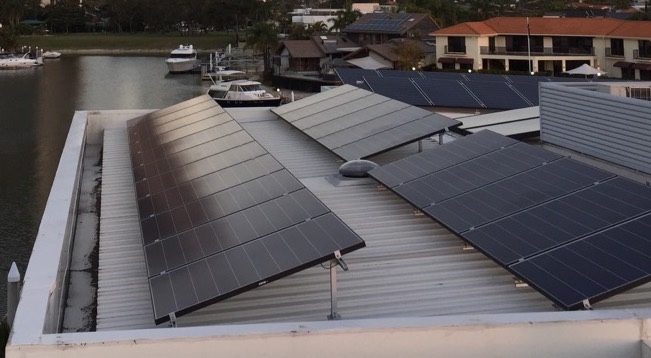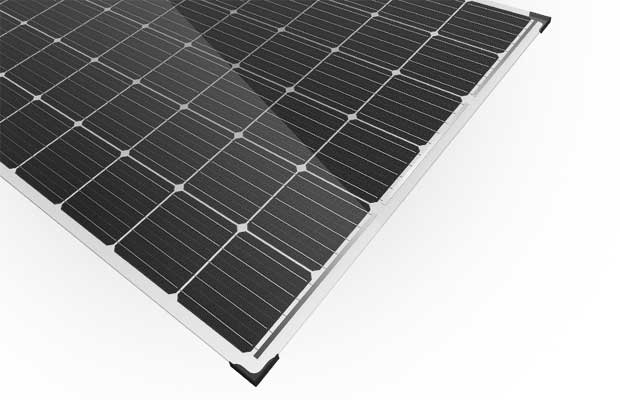Is Your Roof Angle Suitable For Solar Panels?
By Finn Peacock, Chartered Electrical Engineer, Fact Checked By Ronald Brakels
The angle your solar panels are mounted at will affect how much power they generate for you.
Generally speaking, (unless your roof is flat) the pitch of your home’s roof is going to be the angle your solar panels are mounted at. In Australia, common roof pitches are 15° or 22.5° – so your modules will most likely be mounted at one of those angles:

What if you have a flat roof?
If your roof is totally flat, then I strongly recommend mounting the solar panels at an angle of at least 10°. This is really important because it will allow any rain to easily run off the modules.
If the rainwater pools on the surface of the solar panel, it is more likely to eventually get through the panels’ seals and into the solar cells themselves. If this happens, it’s game over for the panel as it will experience an earth fault and need to be replaced. Many panels have a warranty condition stipulating they must be mounted at at least 10° from horizontal, so failure to do so could also void your warranty.
Ignore anyone who tells you to have the solar panels laid flat and just add a panel or two to make up for lost efficiency. Horizontal panels are asking for trouble down the line. They will also get a lot dirtier because they will have very little ability to self-clean through rain. You’ll need to manually clean them more often; which is time consuming – and time is money. Added to that, getting up and working on a roof is a safety risk.
For these reasons, if you have a flat roof, most good installers will add the option of a tilt frame to their quote.
As I’ve said, tilt frames on a flat roof are a good idea. But sometimes an installer will propose tilt frames for a roof that already has a small pitch to increase the angle of the solar panels and get a little more power (for the reasons described in the next section). If your installer is proposing tilt-frames for a non-flat roof, I highly recommend that you read this blog post on why tilt frames often aren’t a good idea before proceeding.
If you really want to lay those panels flat then there is an option: frameless solar panels.
These are panels without an aluminium frame, meaning there is no ridge around the panel to collect grime and water. However, frameless panels have proven to be difficult to install given the required clamping zones and can require yearly maintenance, so I don’t recommend them.
Does the amount of tilt angle really matter?
Yes – the tilt of your solar panels will affect how much power they produce because the tilt will affect how much sunlight you capture.
Consider a solar panel flat on the ground that is 1m wide.
If the sun is directly overhead (e.g. at midday in summer), then a 1m wide shaft of sunlight will be completely captured by that solar panel:
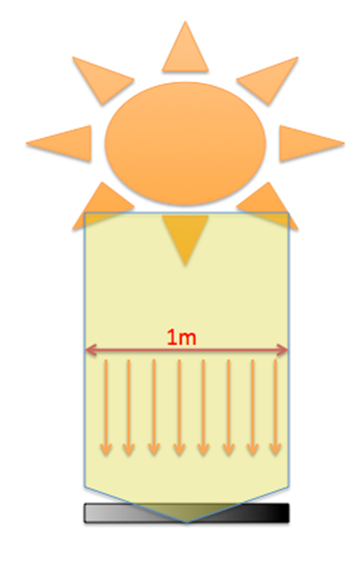
Now, if the sun is at an angle of 30° from horizontal, that same 1m wide shaft of light actually is spread out over 2m when it hits the ground:
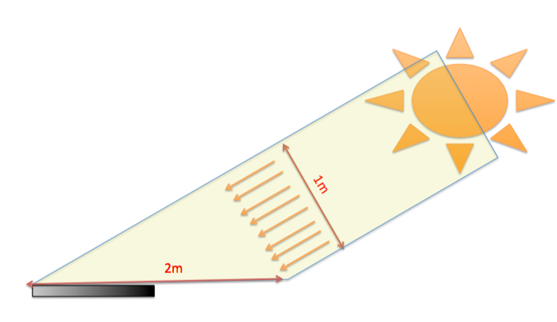
The flat solar panel in this example will only get half the sunlight, and therefore produce half the energy compared to the sun being directly overhead.
A solution is to tilt the panel by 60° so it captures all the sunlight:
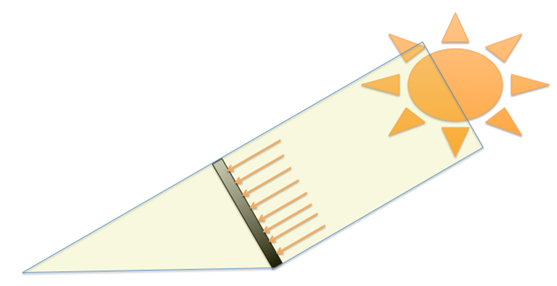
So what is the best angle for a solar panel?
The angle of the sun in the sky depends on both the season and your location. In winter the sun is lower in the sky, while in summer it is higher. The closer you live to the equator (i.e. the lower your latitude), the higher the sun is in the sky all year round. Also, the best tilt is affected by local weather patterns.
This makes calculating the optimum tilt for the panels complicated, so we’ve worked it out for every Australian capital. If you’re not in a capital, so long as your location is reasonably close, you can use the figure for the nearest capital. The figures below are for rack mounted panels, as mounting them
| City | Optimal Tilt |
| Canberra | 29° |
| Hobart | 32° |
| Darwin | 17° |
| Adelaide | 28° |
| Perth | 26° |
| Brisbane | 25° |
| Melbourne | 28° |
| Sydney | 29° |
So for my house in Adelaide, the perfect panel angle to maximize solar generation is 28° from horizontal.
The figures above are for tilt frame mounted panels, as this is the only way you’re likely to have them at the ideal angle. If they’re instead flush with the roof, as in a typical rooftop installation, the ideal angle can be slightly higher.
How much power do you lose if your roof is at a different angle to your latitude?
In a perfect world (well my perfect world anyway) all roofs would be built at the ideal pitch to maximize solar output. However, as mentioned before, most roofs in Australia are at 15° or 22.5°.
So how much solar power are you losing if your panels are not at the perfect tilt angle?
Well, it depends on your geographical location, the direction (orientation) of your roof and your roof’s pitch. If you want to calculate it yourself, then the easiest way is use our power loss table. Just pick the capital city nearest to you and find the power loss.
Let’s use my home in Adelaide as an example. The roof pitch is 15°, which is 13° lower than the ideal angle of 28°.
When you crunch the numbers, the hit to generation is only 2% – almost nothing.
However, if my roof were flat output would be 12% lower compared to having the solar panels at 28°.
So the moral of the story is: if your roof is pitched at more than 10°, your solar panels are probably not at their theoretically perfect tilt angle, but they will be close enough.
If your roof is totally flat, then I advise mounting solar panels on tilt-frames to avoid water pooling problems and to allow for self-cleaning in the rain. And if you are getting tilt-frames – provided they let you tilt the panels high enough and this doesn’t cause them to shade panels behind them – you might as well mount them at the perfect angle for your location to maximise the energy generated over the course of a year.
